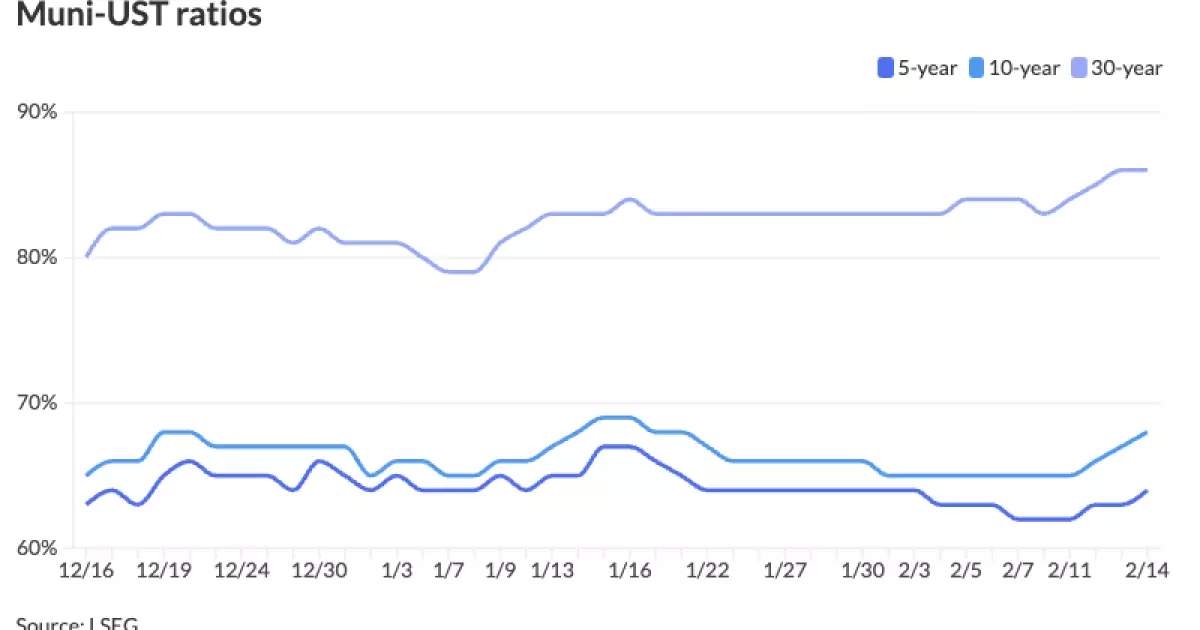The municipal bond market is experiencing notable shifts as recent economic indicators influence trading activities. With U.S. Treasury yields on the decline, there appears to be an optimistic outlook among municipal investors, albeit amid an atmosphere of caution. The intersection of economic data and market performance will be analyzed to understand current trends and what the future may hold for investors in the municipal bond arena.
Market Sentiment and Treasury Correlation
The recent softening of U.S. Treasury yields has provided a measure of relief to the municipal bond sector. Investors have reacted favorably to weak employment reports as these indicators traditionally halt market rallies. Nevertheless, the January employment figures present a dichotomy; while they may bolster confidence in municipal securities, they simultaneously add to the challenges stemming from inflation and interest rate volatility. Bank of America (BofA) strategists noted that the recent consumer price index (CPI) report triggered a phenomenon known as “bear steepening,” thereby contributing to an unpredictable trading environment across municipal bonds.
Barclays strategist Mikhail Foux emphasized that this week’s inflow of tariff announcements had minimal impact on market rates, positioning municipal bonds to be less volatile than Treasuries. As rates fluctuate due to various economic reports, including those related to inflation, traders must navigate the complexities of these changes. Investors should brace themselves for a potentially range-bound period for Treasury yields, contingent upon sustained inflation readings. Navigating this uncertain landscape will require vigilance and strategic adaptability among investors in municipal finance.
Muni Trading Dynamics and Issuance Outlook
Upcoming issuance calendars indicate a contraction in new bond supply, particularly as next week’s estimated issuance falls to $5.5 billion due to the holiday-shortened week. Despite this pullback, underlying demand remains robust. The Bond Buyer’s 30-day visible supply reports a healthy balance at $10.42 billion, illustrating that strong redemption volumes and coupon payments are outpacing new issuance. BofA strategists remain optimistic, indicating that “mutual funds inflows are largely positive,” which will further bolster the municipal bond market’s resilience.
By mid-February, a revival in refunding volumes suggests that the bond market has responded favorably to prior rallies, marked by a 35 basis point decline in 10-year municipal yields since mid-January. This reaction showcases a rekindled appetite for municipals as safe-haven investments, resulting in approximately $4.2 billion in refunding volumes. With indicators suggesting that issuance demand will remain firm, municipal investors could anticipate a stable inflow of opportunities intermittently throughout the upcoming months.
Examining the relationship between municipal and U.S. Treasury yields reveals interesting dynamics. The yield ratios have shifted slightly, with two-year municipal bonds trading at 63%, a modest adjustment from earlier periods. This metric reflects how investors weigh the trade-offs between holding municipal bonds versus Treasuries. As high-grade municipal bonds maintain their appeal amidst changing market conditions, analysts should focus on the implications of yield curves. Notably, the AAA curve has steepened, suggesting a growing defensive posture among investors regarding exposure to duration risk.
The sharp increase in the AAA slope underscores a fundamental change in investor strategies over the past year. Comparatively, investors are now more cautious than they were during a period of deep inversion last year, showcasing an evolving appetite for risk and return. BofA’s observation of steepening slopes, particularly related to 10s30s spreads, signals that there may be opportunities to optimize returns within maturity strategies, depending on how macroeconomic pressures unfold.
Next week holds substantial promise for the municipal market, with an estimated $5.5 billion in new issuances—primarily dominated by negotiated offerings. High-profile deals such as those from Miami-Dade County’s airport revenue bonds and the Pennsylvania Economic Development Financing Authority’s infrastructure programs are likely to attract significant investor interest. The competitive calendar is buoyed by a robust offering of general obligation school bonds, signaling a sustained commitment to financing public infrastructure through municipal bonds.
Despite uncertainties surrounding economic data and external pressures, the municipal bond market appears poised for a stable trajectory. Investor confidence, backed by consistent demand, should lend itself to an environment where municipal securities continue to provide reliable opportunities. For both seasoned investors and newcomers alike, understanding the nuances of the current market will be vital in navigating the evolving landscape of municipal finance.

